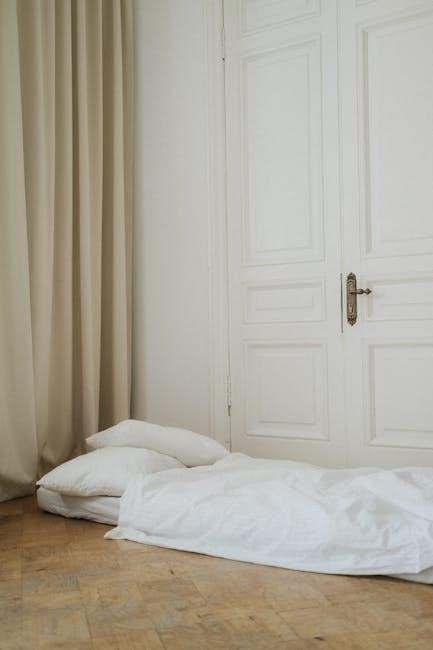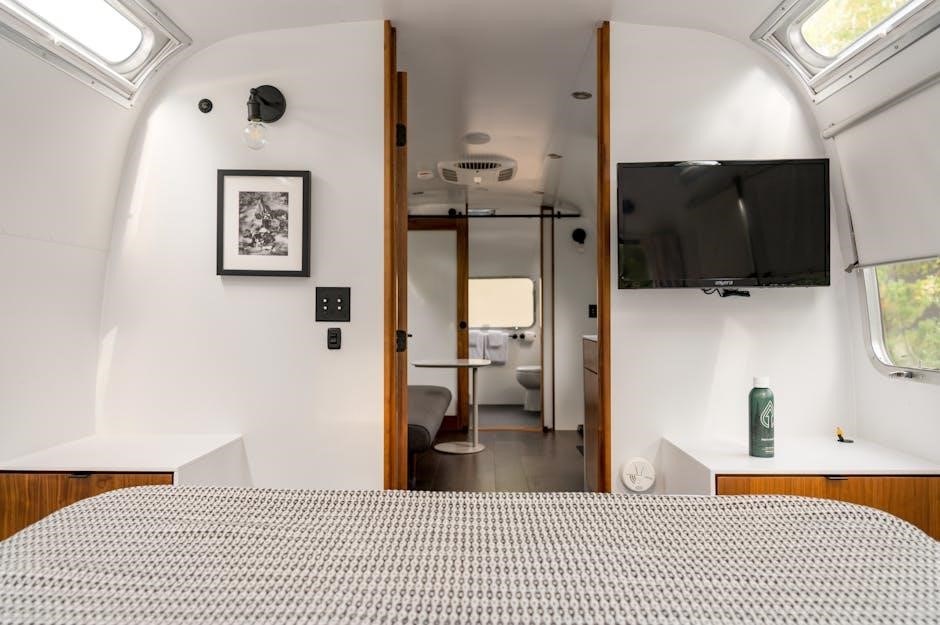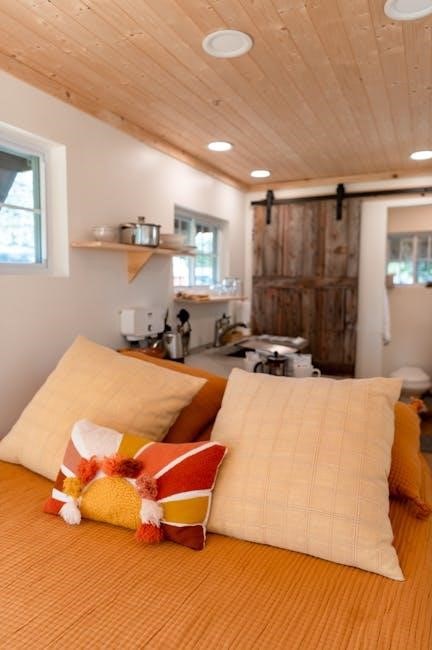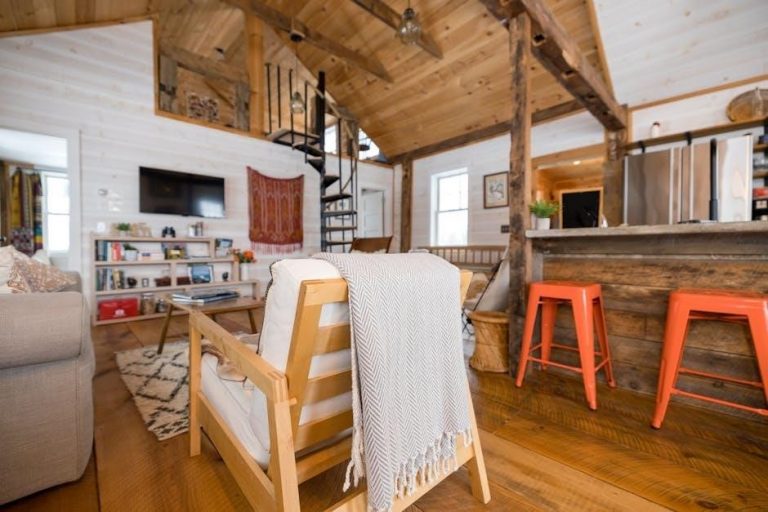Welcome to our guide on bunk beds with futons, a versatile and space-saving furniture solution․ Perfect for small rooms, these beds combine sleeping and seating options, offering comfort and practicality for everyday use․
What is a Futon Bunk Bed?
A futon bunk bed is a versatile furniture piece that combines the functionality of a bunk bed with the flexibility of a futon․ It typically features a top bunk for sleeping and a bottom bunk that doubles as a futon, which can be used as a sofa during the day and folded out into a bed at night․ This design is ideal for small spaces, such as apartments, dorm rooms, or guest rooms, as it maximizes space while providing both seating and sleeping options․ Available in various sizes like twin-over-futon or full-over-futon, futon bunk beds offer a practical and comfortable solution for multi-functional living․ They are perfect for accommodating guests, siblings, or anyone seeking a space-saving sleeping arrangement․
Benefits of a Futon Bunk Bed
A futon bunk bed offers numerous benefits, making it a practical choice for various living situations․ Its space-saving design is ideal for small rooms, apartments, or dorms, providing both a sleeping area and a comfortable seating option․ The versatility of the futon allows it to serve as a sofa by day and a bed by night, maximizing functionality․ It is cost-effective, eliminating the need for separate furniture pieces․ Additionally, futon bunk beds are perfect for accommodating guests or siblings, offering a cozy and efficient solution․ They are also stylish, with modern designs that enhance room aesthetics․ Overall, a futon bunk bed is a durable and versatile investment for any home, blending practicality and comfort seamlessly․

Choosing the Right Size and Style
Measure your space to ensure a proper fit, considering both upright and flat futon positions․ Choose from twin-over-futon or full-over-futon sizes, and opt for metal or wood frames based on your needs and decor․
Standard Sizes of Futon Bunk Beds
Futon bunk beds typically come in twin-over-futon or full-over-futon configurations․ Twin-over-futon models feature a standard twin mattress on top and a twin-sized futon below, ideal for smaller spaces․ Full-over-futon models offer a full-sized mattress on top and a full-sized futon beneath, providing additional comfort and space․ Both options are designed to be compact, making them perfect for apartments, dorm rooms, or guest rooms․ The futon section usually matches the size of the top bunk, ensuring a seamless transition between seating and sleeping․ When choosing a size, consider the room’s dimensions and the intended use to ensure the best fit for your needs․
Measuring Your Space for the Perfect Fit
Measuring your space is crucial before purchasing a futon bunk bed․ Start by assessing the room’s dimensions, including ceiling height, to ensure the bed fits comfortably․ Consider the bed’s vertical clearance, especially for the upper bunk, to prevent hitting the ceiling․ Measure the floor space where the bed will go, ensuring enough room for the futon to lie flat when converted․ Account for any obstructions, such as doors or windows, and leave adequate clearance for safe movement around the bed․ Proper measurement ensures a snug, functional fit and prevents assembly issues․ Always double-check the manufacturer’s specifications against your room’s dimensions for the best results․

Safety Features to Consider
Ensure the bunk bed has sturdy guardrails and a secure ladder․ Check weight limits and structural integrity․ Proper mattress sizing is essential for safety and comfort․
Weight Limits and Structural Integrity
Weight limits are crucial for ensuring the bunk bed’s stability and safety․ Typically, the upper bunk has a lower weight capacity compared to the futon below․ Structural integrity depends on the frame’s material, with metal frames often supporting more weight than wooden ones․ It’s essential to adhere to the manufacturer’s guidelines to prevent any structural compromise․ Checking for certifications like those from reputable safety organizations can provide additional assurance․ Always verify the weight limits before assembly and use, especially if the bed will be used by adults or multiple individuals․ Ignoring these limits can lead to potential hazards, making it vital to prioritize this aspect for long-term durability and user safety․
Guardrails and Ladder Safety
Guardrails are essential for preventing falls from the upper bunk, especially for children․ Ensure guardrails run the full length of the bed and are securely attached․ If placing the bed near a wall, position the guardrail against the wall to avoid entrapment․ Ladders should be sturdy, with non-slip steps and handrails for safe climbing․ Always instruct users to maintain three points of contact when using the ladder․ Night lights can enhance safety by illuminating the area around the bed․ Regularly inspect guardrails and ladders for damage or loose parts․ Teach children to climb carefully and avoid horseplay․ Proper installation and adherence to safety guidelines can significantly reduce the risk of accidents, ensuring a secure sleeping environment for all users․

Assembly Instructions
Start by unpacking and sorting all hardware․ Assemble the bed frame, attach legs, and install guardrails․ Secure the ladder and ensure all bolts are tightened․ Refer to the manual for specific instructions and contact customer support if parts are missing or damaged․ Follow each step carefully to ensure stability and safety․
Step-by-Step Assembly Process
Begin by unpacking and organizing all parts․ Assemble the bottom futon frame first, ensuring all bolts are securely tightened․ Attach the legs and support slats for stability․ Next, construct the top bunk, following the manufacturer’s instructions for proper alignment․ Install the guardrails on both sides of the top bunk to enhance safety․ Attach the ladder to the frame, making sure it is sturdy and evenly aligned․ Once the structure is complete, place the futon mattress on the bottom and the standard mattress on the top bunk․ Double-check all connections and ensure the bed is level․ Refer to the provided manual for specific diagrams and tightening sequences․ Contact customer support if any parts are missing or if clarification is needed․
Tools and Hardware Required
To assemble a bunk bed with a futon, you will need an Allen wrench, screwdriver, and a wrench or socket set․ The hardware typically includes bolts, screws, washers, and nuts․ Ensure all parts are included in the package, such as support slats, guardrails, and ladder components․ Refer to the instruction manual for specific tools recommended by the manufacturer․ Organize all parts and hardware before starting to streamline the assembly process․ If any items are missing or damaged, contact customer support promptly․ Having a second person assist can make the process safer and more efficient․ Always follow safety precautions to avoid injury or damage to the bed frame․
Troubleshooting Common Assembly Issues
Common issues during assembly include missing or damaged parts, misaligned holes for bolts, and instability of the structure․ Verify all components are included and undamaged before starting․ If bolts don’t fit, double-check the instructions to ensure correct placement․ For wobbling, ensure all screws are tightened evenly and the frame is level․ If the futon mechanism doesn’t operate smoothly, inspect the hinges and lubricate if necessary․ Consult the manual for specific solutions, and contact customer support if problems persist․ Proper assembly ensures safety and longevity of the bunk bed with futon․ Always follow safety guidelines to avoid structural issues and ensure a sturdy final product for daily use․

Maintenance and Care
Regular vacuuming and spot cleaning of the futon keep it fresh․ Rotate the mattress every few months for even wear․ Deep clean as needed for longevity․
Cleaning and Upkeeping the Futon
Regular maintenance ensures the futon remains comfortable and hygienic․ Start by vacuuming the surface to remove dust and debris․ Spot clean stains using a mild detergent and water, gently scrubbing with a soft brush․ For tougher stains, consider using a fabric cleaner specifically designed for upholstery․ Allow the futon to air dry completely to prevent moisture buildup․ Rotate the futon mattress every few months to ensure even wear and extend its lifespan․ For deeper cleaning, some futons can be machine washed, but always check the manufacturer’s instructions first․ Proper upkeep will keep your futon looking and feeling its best for years to come․
Supporting the Mattress for Longevity
Proper support is essential to extend the life of your futon mattress․ Ensure the futon is placed on a sturdy bed frame or foundation designed for its size and weight․ A solid surface, like a bed slat system, prevents sagging and maintains the mattress’s shape․ Regularly rotate the futon mattress to promote even wear and tear․ For added support, consider using a mattress topper specifically designed for futons․ Avoid placing the futon directly on the floor without proper ventilation, as moisture can accumulate and damage the material․ By providing the right support, you can enjoy your futon for years, maintaining its comfort and structural integrity․
